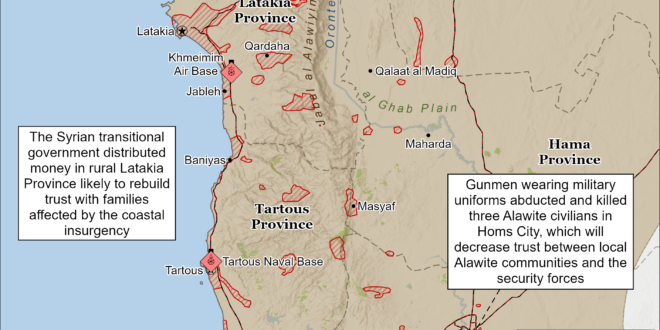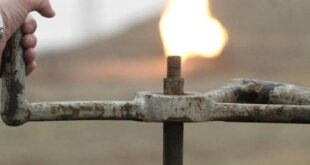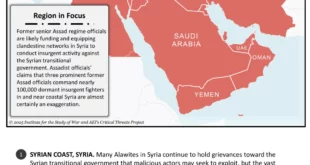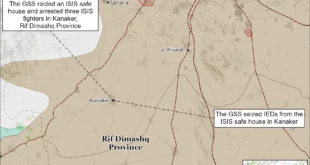A Senior Iranian official threatened to reduce cooperation with the International Atomic Energy Agency (IAEA) if external threats against Iran continue. Iranian Supreme Leader Adviser Ali Shamkhani stated on April 10 that Iran could expel IAEA inspectors, halt cooperation with the agency, or move enriched uranium to “safe and unknown locations” if external threats and military pressure continue.[1] Iran has already restricted IAEA oversight, including withdrawing the designation of several inspectors in September 2023 and barring other top inspectors in November 2024.[2] Shamkhani’s remarks may possibly aim to deter a potential US or Israeli strike on Iranian nuclear facilities and may also seek to instill urgency among Western officials for renewed negotiations.
China increased its Iranian oil imports by at least 80 percent in March compared to February.[3] This undermines the US “maximum pressure” campaign, which seeks to drive Iranian oil exports to zero, and illustrates cooperation between two major US adversaries. Reuters reported on April 10 that China’s imports of Iranian oil increased significantly in March amid concerns that new US sanctions could further restrict the Iranian oil supply, citing unspecified traders and analysts.[4] Estimates show that Iran shipped between 1.3 to 1.8 million barrels per day to China in March. Most of these exports are transferred off the coast of Malaysia and Singapore and reflagged as Malaysian. China remains the largest importer of Iranian oil, buying 90 percent of Iran’s total oil exports. China’s Iranian oil imports help Iran circumvent US sanctions. Iran, China, and Russia issued a joint statement in mid-March condemning the US “maximum pressure” strategy vis-a-vis Iran.[5] Chinese officials have echoed this statement since.[6]
US Central Command (CENTCOM) conducted at least 9 airstrikes targeting Houthi infrastructure and leadership in Houthi-controlled areas of Yemen since April 9.[7] CENTCOM conducted at least three airstrikes targeting Houthi underground facilities and weapons depots in Mount Nuqum, which is on the eastern outskirts of Sanaa City, for the second consecutive day.[8] CENTCOM conducted at least five airstrikes targeting two other Houthi weapons depots around Sanaa City.[9] CENTCOM targeted Houthi barracks and weapons depots on Kamaran Island, Hudaydah Governorate, for the eighth time since the start of CENTCOM’s airstrike campaign on March 15.[10]
One airstrike may have killed a relatively more high-value Houthi leader in central Sanaa City on April 9. A Yemeni journalist reported that a CENTCOM airstrike on April 9 targeted a car at the roundabout between al Saleh Mosque and the gate of the Presidential Palace in al Sabeen Dstrict, central Sanaa City, and killed three likely Houthi fighters.[11] Armed Houthi fighters surrounded the destroyed vehicle, preventing Sanaa residents from identifying the dead or approaching the vehicle until April 10. Airstrikes targeting vehicles, especially in sensitive areas like the middle of a major population center, usually intend to eliminate senior enemy commanders rather than ordinary foot soldiers or low-level commanders.
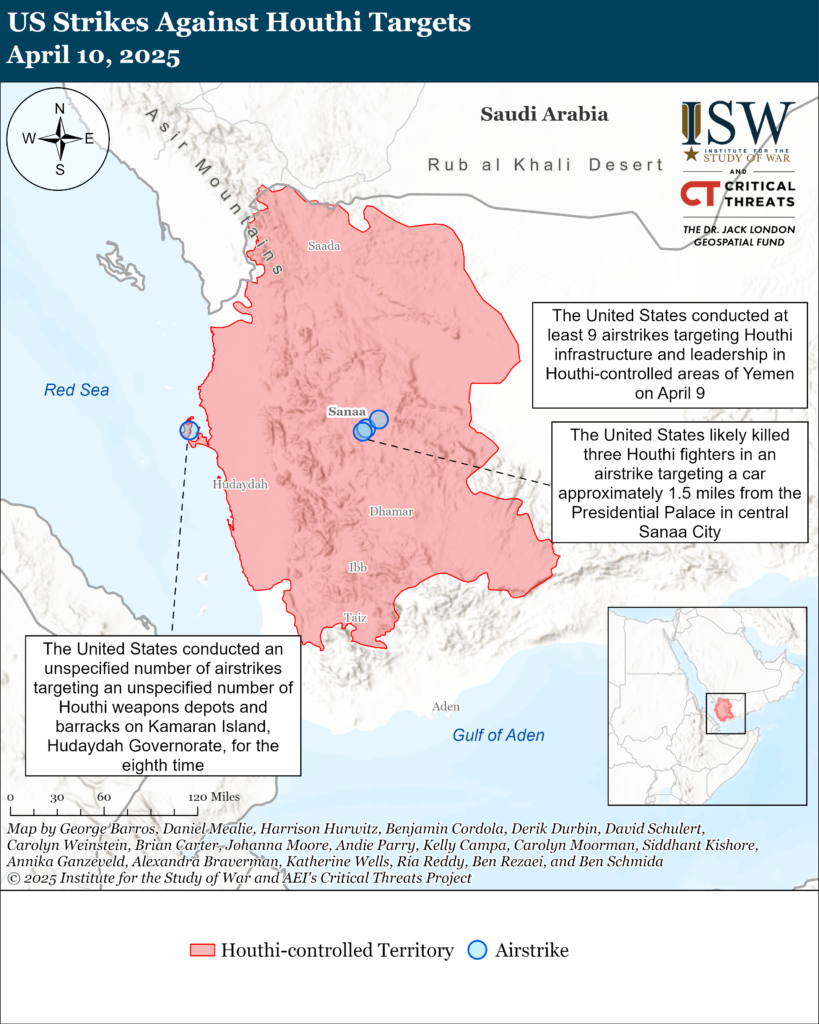
US Secretary of State Marco Rubio stated on April 9 that he discussed “eliminating the threat of the Houthis,” in addition to developments in the Gaza Strip and Syria, with Saudi Foreign Minister Prince Faisal bin Farhan in Washington, DC.[12] Farhan also met with US National Security Advisor Mike Waltz on April 9.[13] US Ambassador to Yemen Steven Fagin separately discussed the role the Yemeni Presidential Leadership Council (PLC) can play “in restoring peace and prosperity to Yemen,” as well as “US efforts to end the Houthi threat to freedom of maritime navigation,” with PLC Vice President Tareq Saleh.[14] These meetings follow CENTCOM Commander General Erik Kurilla’s most recent regional Middle East tour between April 1 and 5. [15] Kurilla met with the Chief of Staff of the Yemeni Armed Forces, Lieutenant General Sagheer Ahmed Aziz, and the Chief of General Staff of the Saudi Arabian Armed Forces, General Fayyad bin Hamed al Ruwayli, in Riyadh between April 3 and 5.[16]
CENTCOM announced the arrival of the USS Carl Vinson carrier strike group in CENTCOM’s area of responsibility on April 10.[17] CENTCOM published footage of the Vinson working alongside the USS Harry S. Truman carrier strike group in the Red Sea. CENTCOM has been launching airstrikes targeting Houthi sites in Yemen from the Truman since March 15.[18]
Syrian Kurds and Druze communities and political factions have signaled concern over the trajectory of the transitional government. Autonomous Administration of North East Syria (AANES) official Badran Jia Kurd told Reuters on April 10 that Kurdish political parties have agreed on a “common political vision” for northeastern Syrian that would include “local legislative councils within the region, executive bodies to manage the region’s affairs, and internal security forces affiliated with them.”[19] These ”political parties” include the Democratic Union Party (PYD) and the Kurdish National Council (KNC), and these unified demands have emerged from recent talks between the two parties.[20] Both parties are longtime rivals, making their unity against the transitional government notable. Jia Kurd said that the Syrian state must preserve each region’s “specificities” by enshrining these “federal” mechanisms in the Syrian constitution.”[21] KNC leader Suleiman Oso said that the joint parties’ “vision” is expected to be announced by the end of April.[22] The Druze community, which is predominantly located in southwestern Syria and remains fractured into several distinct armed factions in political groups, holds similar reservations about joining the transitional government. Major Druze leaders, including Sheikh Hikmat al Hijri and the spokesperson for the Men of Dignity Movement, have expressed that there is “no consensus” with Damascus while adding that they have significant reservations about the transitional government. Both the Kurds and the Druze community have inked some agreements with the transitional government. But the demands by the Kurds and the statements from the Druze community reflect deeply held fears over the trajectory of the transitional government, especially after Syrian Transitional President Ahmed al Shara’s loyalists retained control over all key Syrian ministries in the transitional cabinet formed on March 29.[23] The Syrian transitional government has consistently rejected any decentralization or federalization of the country.[24]
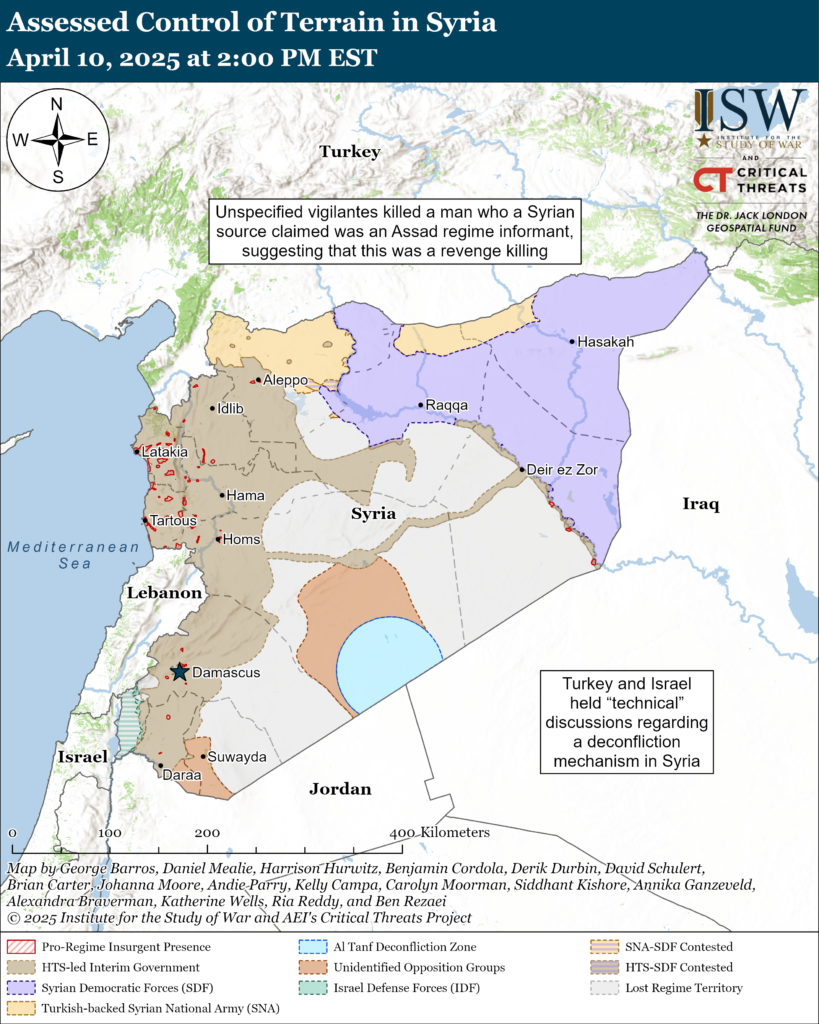
Key Takeaways:
Iran Nuclear Talks: A Senior Iranian official threatened to reduce cooperation with the International Atomic Energy Agency (IAEA) if external threats against Iran continue, which may seek to instill urgency in the nuclear negotiations while deterring a strike on Iran’s nuclear facilities.
Maximum Pressure: China increased its Iranian oil imports by at least 80 percent in March compared to February. This undermines the US "maximum pressure" campaign, which seeks to drive Iranian oil exports to zero, and illustrates cooperation between two major US adversaries.
US Air Campaign in Yemen: CENTCOM has conducted nine airstrikes in Yemen since April 9. One strike may have killed Houthi commanders. The USS Carl Vinson carrier strike group also arrived in the CENTCOM area of responsibility.
US Diplomacy in the Middle East: The US secretary of state discussed Yemen and “eliminating the Houthi threat,” among other issues, with the Saudi foreign minister. CNN previously reported that regional diplomatic efforts were under way for a Yemeni government ground offensive in Yemen.
Syrian Centralization: Syrian Kurds and Druze communities and political factions have signaled concern over the trajectory of the transitional government. Both the Kurds and the Druze community have inked some agreements with the transitional government, but recent demands by the Kurds and statements from the Druze community reflect deeply held fears over the trajectory of the transitional government.Syria
The failure of the Syrian transitional government to prevent targeted killings of Alawite civilians risks deepening sectarian divides and enables Alawite insurgents to exploit grievances. Armed men, reportedly wearing Syrian military uniforms, abducted and killed four Alawite civilians in the Karm al Zeitoun neighborhood of Homs City on April 9.[25] Such killings instill fear and grievances within the Alawite community, which discourages cooperation with the transitional government. Alawite insurgents can further exploit this growing discontent among the Alawites to position themselves as defenders of the local population and justify their attacks on the transitional government. The transitional government’s limited responses—arresting low-level militiamen and offering economic compensation—have so far failed to prevent further sectarian violence.[26] The Syrian transitional government risks losing the trust of Alawite communities and fueling future unrest without transparent judicial proceedings and broader preventative measures.
Vigilantes killed a former mayor in Aleppo City on April 9.[27] A Syrian source identified him as an Assad regime informant, suggesting the attack was a revenge killing.[28] This attack follows a pattern of localized and grievance-based attacks targeting former regime remnants in Syria.[29] These repeated acts of vigilante justice highlight the need for transparent transitional justice. Vigilante justice can also contribute to a climate of fear among those being targeted.
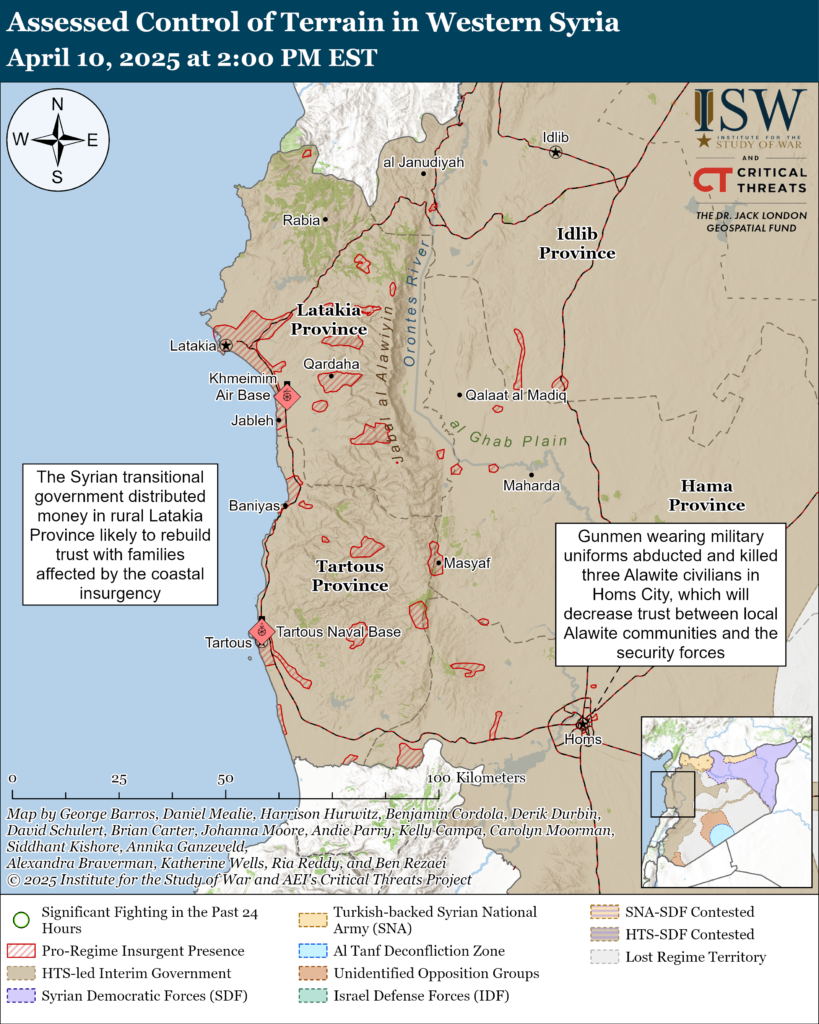
The Syrian transitional government continued to provide economic aid to families in coastal Syria, likely to rebuild trust with families affected by the insurgency.[30] Syrian government officials distributed money to nearly 1,200 families in rural Latakia Province on April 10, expanding an aid initiative that began in Tartous Province in late March.[31] This assistance program aims to support families that were impacted by insurgent attacks or government counter-attacks.[32] These limited grants—reportedly as low as $100 per family—will probably help some families but fall short of addressing the more serious concerns and fears they have about insecurity amid repeated sectarian and revenge-based attacks.[33]
Turkey and Israel held “technical” discussions on April 10 regarding a deconfliction mechanism in Syria.[34] Turkey and Israel began talks to establish a deconfliction zone following Israeli strikes on Tiyas Airbase in Homs Province, where Turkey reportedly plans to establish an airbase.[35] Turkish and Israeli officials held their first official meeting in Azerbaijan on April 9 to establish a deconfliction mechanism.[36] Israel and Russia also used a deconfliction mechanism in Syria to enable Israeli airstrikes on Iranian and Iranian-backed targets, and Israel and Turkey may seek to come to a similar arrangement.[37] An open line of communication between Turkey and Israel could possibly prevent a potential stand-off between the two parties, which both have interests in Syria.
The Syrian Defense Ministry (MoD) plans to replace a local commander from Salamiyah, southeastern Hama Province, with Suleiman Shah Brigades commander Abu Amsha.[38] Salamiyah is an Ismaili-majority town that has shared a cooperative relationship with HTS-led elements within the transitional government since December 2024.[39] Salamiyah-native and former FSA commander Fadi Zouda has led security forces in Salamiyah since December 2024.[40] Two Syria-focused analysts reported on April 9 that the Syrian MoD plans to transfer Zouda to the “sensitive area” of Masyaf, southwestern Hama.[41] Masyaf’s location at the base of the Alawite-majority coastal mountains makes securing the town critical to the transitional government’s counterinsurgency efforts, particularly given the pro-regime insurgent presence in Masyaf and the surrounding area.[42] Masyaf also hosted major Hezbollah and Assad Regime facilities prior to December 2024.
Salamiyah residents are reportedly alarmed over the MoD’s plans to backfill local commander Fadi Zouda with Abu Amsha and his men, which demonstrates some of the difficulties associated with the government’s reliance on incompetent, thuggish commanders.[43] Abu Amsha currently leads the new Syrian army’s 62nd Division, but the division appears to be entirely comprised of Suleiman Shah Brigades fighters.[44] The US Treasury Department has sanctioned both Abu Amsha and the Suleiman Shah Brigade for human rights abuses against Kurds, and the militia was reportedly responsible for sectarian massacres on the Syrian coast in early March.[45] Salamiyah residents have reportedly “mobilized” to keep Zouda in command over the town.[46] Salamiyah’s concerns are especially notable because the town has been very supportive of the new government, and their backlash demonstrates the low regard many Syrians hold for some senior Syrian militia commanders.
Iraq
Axis of Resistance Objectives:
Strengthen Iranian and Axis of Resistance influence over the Iraqi state and society
Harden the Iraqi government against internal dissentIraqi news released additional information regarding the proposed Popular Mobilization Forces (PMF) Law.[47] The PMF is an Iraqi state security service composed of a plethora of militias, some of which are Iranian-backed Iraqi militias who nominally report to the Prime Minister but, in reality, report to the Islamic Revolutionary Guards Corps (IRGC) Quds Force.[48] Independent Iraqi news outlet al Mada reported on April 9 that under the proposed law, Iranian-backed armed factions that report to brigades under the PMF would be integrated into the PMF.[49] These armed factions have been used to obfuscate the role that Iranian-backed brigades within the PMF play in threats against US forces in Iraq and Syria.[50] The law would require PMF brigades to only carry out orders as directed by the prime ministers, as already required under Iraqi law, and refrain from attacks on US interests or other unspecified targets outside of Iraq.[51] The PMF Law would also “merge” the PMF with the Iraqi Security Forces (ISF).[52] It is unclear whether these PMF units would be reflagged or distributed across existing ISF units.
The Turkish Armed Forces killed 18 fighters in northern Iraq and Syria over the past two weeks.[53] Turkish Armed Forces also captured one Kurdistan Workers’ Party (PKK) fighter in the area. Turkey identifies the targets of its operations in Syria as “PKK,” even when striking forces under the SDF.[54] Kurdish media reported on April 10 that Turkish forces shelled PKK positions near Zibari District, Duhok Province, Iraqi Kurdistan.[55]
Arabian Peninsula
Axis of Resistance objectives:
Harden the Houthi regime against internal dissent in Houthi-controlled areas
Destroy the anti-Houthi opposition in order to control all of Yemen
Erode Israeli will to continue the war in the Gaza StripSee topline section.
The Palestinian Territories and Lebanon
Axis of Resistance objectives:
Erode the will of the Israeli political establishment and public to sustain clearing operations in the Gaza Strip
Reestablish Hamas as the governing authority in the Gaza Strip
Rebuild and reestablish Hezbollah in southern Lebanon
Establish the West Bank as a viable front against IsraelNothing significant to report.
CTP-ISW will not be covering the new Israeli operation in the Gaza Strip. We have reprioritized our Middle East coverage to focus on Iran’s nuclear program, Iranian domestic security, and Iranian efforts to rebuild its networks into the Levant, including the Palestinian Territories. Given that Israel and its partners have destroyed Hamas’s military organization and severed the group’s ability to resupply itself, we are now focused on how Iran seeks to rebuild its lines of communication with Hezbollah and Hamas through Syria.
Iranian Decision-Making, Internal Dynamics, and Foreign Policy
The Iranian rial depreciated from 999,000 rials to one US dollar on April 9 to 1,009,500 rials to one US dollar on April 10.[56]
Iran and Belarus continued to develop their strategic relationship. Iran and Belarus signed a memorandum of understanding (MOU) on April 10 to expand bilateral trade along the International North-South Transport Corridor (INSTC).[57] This MOU comes after Iran and Belarus signed a defense MOU in early March to expand defense industrial cooperation.[58]
The Iran Update provides insights into Iranian and Iranian-sponsored activities abroad that undermine regional stability and threaten US forces and interests. It also covers events and trends that affect the stability and decision-making of the Iranian regime. The Critical Threats Project (CTP) at the American Enterprise Institute and the Institute for the Study of War (ISW) provides these updates regularly based on regional events.
CTP-ISW defines the “Axis of Resistance” as the unconventional alliance that Iran has cultivated in the Middle East since the Islamic Republic came to power in 1979. This transnational coalition is comprised of state, semi-state, and non-state actors that cooperate to secure their collective interests. Tehran considers itself to be both part of the alliance and its leader. Iran furnishes these groups with varying levels of financial, military, and political support in exchange for some degree of influence or control over their actions. Some are traditional proxies that are highly responsive to Iranian direction, while others are partners over which Iran exerts more limited influence. Members of the Axis of Resistance are united by their grand strategic objectives, which include eroding and eventually expelling American influence from the Middle East, destroying the Israeli state, or both. Pursuing these objectives and supporting the Axis of Resistance to those ends have become cornerstones of Iranian regional strategy.
 Eurasia Press & News
Eurasia Press & News
